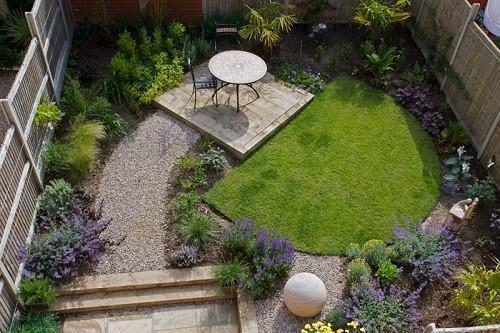Landscaping of a small plot
 Not all owners have plots with a large area. Often summer residents are limited in space to 6 acres, and you really want to fit as much as possible there, starting from buildings and ending with a garden. How to properly plan the landscape design of a small area so that there is room on it not only for the beds, but also for garden trees? What needs to be considered to make it look beautiful?
Not all owners have plots with a large area. Often summer residents are limited in space to 6 acres, and you really want to fit as much as possible there, starting from buildings and ending with a garden. How to properly plan the landscape design of a small area so that there is room on it not only for the beds, but also for garden trees? What needs to be considered to make it look beautiful?
There are a large number of improvement options, but all of them are united by the main emphasis - to make the site visually more spacious.
Advantages and disadvantages of small areas
Small country estates have both pros and cons. The benefits of a small space include:
- low financial costs for creating a garden;
- the site is easy to care for and maintain, it does not take much time:
- visually, such areas look more comfortable, since they are easier to organize;
- when creating garden compositions, it is easier to keep them in the same style.
The disadvantages are that:
- such a site is fully visible;
- it is difficult to place additional buildings on it;
- the distance from the walls of the house to the fence and neighboring buildings is very small;
- there is no possibility of complete solitude and silence.
Secrets of Beautifying a Beautiful Garden in a Limited Space
When developing landscape design For a small area, experts recommend adhering to certain rules:
- Dissolve the garden boundaries of the site (fence). It is necessary to make sure that the fence is not visible immediately and completely. It is better to hide it under green climbing plants. Alternatively, trees can be planted near the fence itself, medium-sized shrubs can be planted in the middle, and in front, the composition can be supplemented with low-growing plant species. The main thing is that the plantings have a varied shape and color and do not merge into a solid line.
- Free the view of the garden. To visually increase the space, sow the garden's view area with lawn grass.
- "Break" the correct shape of the site. This is especially important in narrow and long areas. In this case, it is better to arrange garden paths and flower beds diagonally, in the form of geometric shapes (rhombus, triangle, circle) or make them winding.
- Remove corners. To free the central part of the site, you need to use the corner space and place useful objects on it (gazebos, playgrounds, pool).
- Create relief. The division of the site into multi-level zones with the help of high beds, alpine slides or partitions will help to visually increase the size.
- Use a "mirror" effect. Repeat on the site elements that exist outside of it. This landscape design technique will help push virtual boundaries. You can also install real mirrors or build a pond to reflect the surrounding nature.
- Combine and combine buildings into a single complex of buildings.
- Use vertical lines in the form of tall pots, hedges, trellis screens.
- When creating garden compositions, take into account the general color scheme. Cool tones enhance the space, while warm tones give it a cozy feel.
- Use suitable plants and do not overload the site with too large stands or tall trees.
- Combine materials and use different textures.